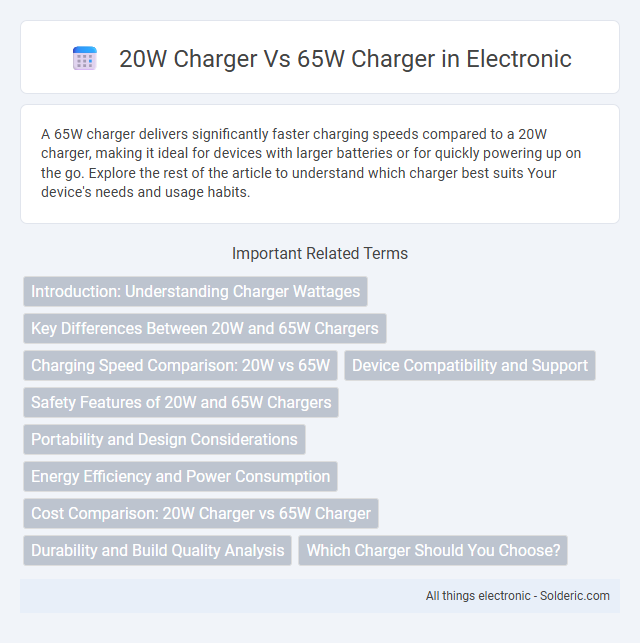A 65W charger delivers significantly faster charging speeds compared to a 20W charger, making it ideal for devices with larger batteries or for quickly powering up on the go. Explore the rest of the article to understand which charger best suits Your device's needs and usage habits.
Comparison Table
| Feature | 20W Charger | 65W Charger |
|---|---|---|
| Power Output | 20 Watts | 65 Watts |
| Charging Speed | Standard fast charging | Ultra-fast charging |
| Device Compatibility | Smartphones, small tablets | Laptops, tablets, smartphones |
| Charging Time (Example) | 60% in 30 minutes (smartphone) | 80% in 30 minutes (laptop) |
| Port Type | Usually USB-C | USB-C with Power Delivery |
| Size & Weight | Compact and lightweight | Larger, heavier |
| Price | Lower cost | Higher cost |
| Use Case | Everyday phone charging | High-power device charging and multitasking |
Introduction: Understanding Charger Wattages
A 20W charger provides sufficient power for most smartphones and small devices, enabling efficient charging without overheating risks. In contrast, a 65W charger delivers significantly higher power, ideal for rapidly charging larger devices like laptops or tablets, reducing overall charging time. Your choice between a 20W and 65W charger depends on the device's power requirements and how quickly you need it charged.
Key Differences Between 20W and 65W Chargers
A 20W charger delivers slower charging speeds suitable for smartphones and small devices, while a 65W charger supports rapid charging for laptops, tablets, and larger electronics, significantly reducing charge time. The 65W charger often includes advanced power delivery technology and multiple ports for simultaneous device charging. Your choice depends on device compatibility and charging speed needs, with 65W chargers offering greater versatility and efficiency for power-hungry gadgets.
Charging Speed Comparison: 20W vs 65W
A 65W charger delivers significantly faster charging speeds than a 20W charger, often recharging compatible devices up to three times quicker due to its higher power output. The 20W charger is suitable for everyday use and smaller devices, but it may take several hours to fully charge larger batteries. For faster power restoration, your device must support high-wattage charging protocols to benefit from the 65W charger's capabilities.
Device Compatibility and Support
A 20W charger is typically compatible with most smartphones and small tablets, providing sufficient power for everyday charging needs without risking device damage. A 65W charger supports a wider range of devices, including laptops, larger tablets, and fast-charging smartphones, offering versatile charging with higher power delivery. Ensuring your device supports the charger's wattage is essential for optimal performance and safety, making it important to match Your gadget with the correct charger specifications.
Safety Features of 20W and 65W Chargers
20W chargers typically include basic safety features such as overcurrent protection, short-circuit protection, and temperature control, making them suitable for everyday device charging with minimal risk. In contrast, 65W chargers incorporate advanced safety technologies like overvoltage protection, surge protection, and intelligent power distribution to handle higher power output safely and efficiently. When choosing your charger, consider that higher wattage models offer enhanced safeguards for demanding devices, ensuring both fast and secure charging.
Portability and Design Considerations
A 20W charger is significantly more compact and lightweight, making it ideal for portability and travel without adding bulk to your bag. In contrast, a 65W charger, while larger and heavier, often features advanced cooling systems and robust build quality that cater to high-performance devices. Choosing between the two depends on your need for a balance between convenience in carrying and the power requirements of your devices.
Energy Efficiency and Power Consumption
A 20W charger typically consumes less energy during low-demand charging sessions, making it more energy-efficient for devices with smaller batteries or light use. In contrast, a 65W charger delivers higher power output, reducing overall charging time but potentially increasing power consumption and heat generation during rapid charging cycles. Optimizing charger choice based on device battery capacity and usage patterns can enhance energy efficiency and minimize unnecessary power waste.
Cost Comparison: 20W Charger vs 65W Charger
A 20W charger typically costs between $10 to $20, making it a budget-friendly option for basic charging needs, while a 65W charger ranges from $30 to $60, reflecting its advanced capabilities and faster charging speeds. The higher initial investment in a 65W charger can be justified by its efficiency in reducing charging time for laptops and smartphones, potentially saving you time and enhancing productivity. When considering cost-effectiveness, factor in your charging frequency and device compatibility to determine if the premium price of a 65W charger aligns with your needs.
Durability and Build Quality Analysis
A 65W charger generally offers enhanced durability and build quality due to its design for higher power output, often incorporating better heat dissipation materials and robust internal components compared to a 20W charger. You can expect a 65W charger to have reinforced connectors and premium casing to withstand prolonged heavy use without degradation. However, both chargers may vary by brand, so checking specific product reviews for build quality is essential before making a choice.
Which Charger Should You Choose?
Choosing between a 20W charger and a 65W charger depends on your device's power requirements and charging speed preferences. A 65W charger delivers significantly faster charging, especially for laptops and high-capacity devices, while a 20W charger is sufficient for smartphones and smaller gadgets. Your ideal choice balances convenience, device compatibility, and the urgency of charging time.
20W charger vs 65W charger Infographic

 solderic.com
solderic.com